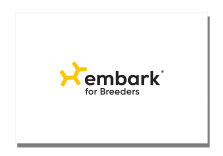Neuronal Ceroid Lipofuscinosis 8, NCL 8
Neuronal ceroid lipofuscinoses (NCLs) are lysosomal storage diseases that cause the accumulation of ceroid-lipofuscin in multiple areas of the brain and retinas. A lysosome is a structure within the cell that digests and removes waste. When the lysosome cannot recycle waste properly, the waste accumulates and causes the cell to die.
-
Signs and symptoms
Common symptoms reflect central nervous system (CNS) malfunction and progress from anxiety, noise sensitivity, and restlessness to impaired vision and hearing. Epileptic-like seizures, loss of house training skills, and difficulties walking may develop later in the course of the disease, which typically leads to severe quality of life issues around two years of age.
In Salukis, NCL 8 has been observed with signs beginning at around one year of age. -
Diagnosis
Diagnosis is made based on clinical history, physical examination, genetic testing, and ruling out other causes of similar symptoms. Histopathology of the brain may offer a definitive diagnosis after the affected dog is deceased. Clinical signs of NCL 8 may mimic many other CNS diseases, so examination by a veterinarian or veterinary neurologist is required. Advanced imaging (CT or MRI scan) and/or a spinal tap may be performed to rule out other diseases.
-
Treatment
There is currently no treatment for NCL 8. Gene therapy is an evolving field but requires more research to be available clinically. Some medications aimed at controlling seizures may offer a temporary reduction in their frequency, however, the medications will eventually stop controlling the seizures.
-
What to do if your dog is at risk
Actions
- Please give your dog any medication as prescribed by your veterinarian.
- Keeping your affected dog comfortable at home is the best therapy you can provide.
- Slings can be used to assist with their mobility, and caution should be taken to avoid falling hazards.
- Blind dogs may benefit from leaving your furniture in the same place and being put on leashes in unfamiliar territory.
-
Genetic Information
CLN8 belongs to a family of proteins known to function in lipid synthesis and transport. Unlike many proteins that cause NCL, CLN8 is found in the endoplasmic reticulum and likely participates in the shuttling of lipoproteins out of the endoplasmic reticulum.
Neuronal Ceroid Lipofuscinosis 8 is recessive, that is, a dog requires two copies of the variant to show signs of the disease from the variant. This variant was first described in Saluki.
Gene names:
CLN8 ‐ chr
Inheritance type:
recessive
Citations:
-
Breeds affected
This health condition affects the following breeds
Learn about your dog’s unique genetic health
Dog owners
Breed identification, health and trait insights, personalized care recommendations, and the world’s first canine relative finder—all in one leading dog DNA test.
Learn about the report for dog ownersShop the test
Breeding programs
Embark’s test for breeding programs is one comprehensive DNA test designed with your needs in mind.
Learn about the report for breedersShop the test











